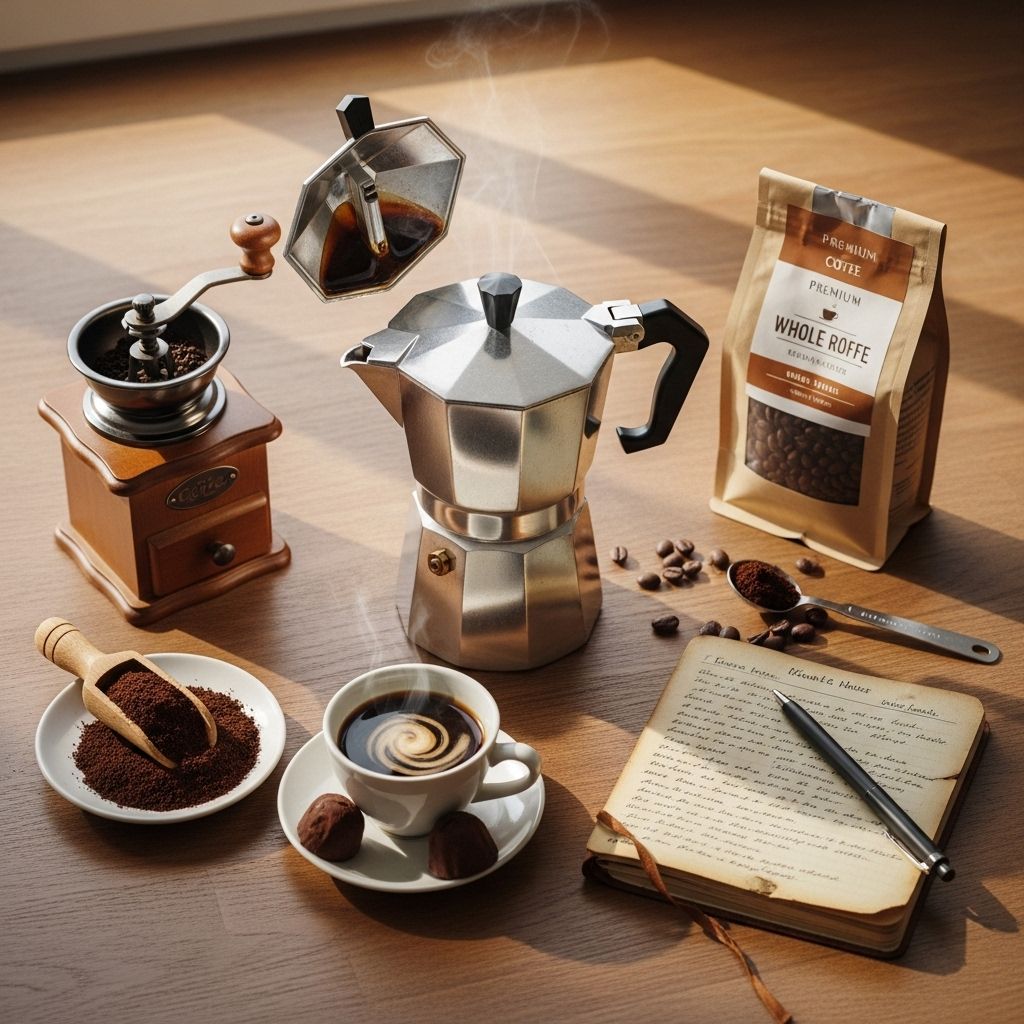Moka Pot: Comprehensive Guide To Espresso-Style Coffee At Home
Stove-top ritual yields intense, barista-worthy cups without costly machines.

Moka Pot: The Budget-Friendly Alternative to Espresso
The moka pot occupies a unique place in global coffee culture. Revered in Italy and adopted across the world, this humble stovetop device claims the title of the most accessible way to enjoy bold, concentrated coffee at home—without the cost or complexity of an espresso machine. Whether you’re a seasoned home barista or a curious coffee fan seeking an affordable upgrade, understanding the moka pot’s capabilities and limitations will bring you closer to brewing satisfying, espresso-style coffee in your own kitchen.
What Is a Moka Pot?
The moka pot, also known as a stovetop espresso maker, is a low-tech coffee brewer invented by Alfonso Bialetti in 1933. The classic hourglass-shaped device uses steam pressure to force hot water upward through coffee grounds, producing a rich, aromatic, and strong cup of coffee reminiscent of Italian café-style espresso. Though it doesn’t generate the intense pressure found in professional machines, its unique brewing process creates a dense, flavorful coffee far surpassing typical drip or French press methods.
Key Features of the Moka Pot
- Three-Part Design: Consists of a bottom chamber for water, a metal filter basket for coffee grounds, and a top chamber to collect brewed coffee.
- Affordable: Most moka pots cost under $50, with some reliable options even cheaper.
- Portable and Durable: Light, compact, and typically made from sturdy aluminum or stainless steel.
- Easy to Use: Requires only a stove and a few simple steps to operate.
How the Moka Pot Works
At its heart, the moka pot harnesses basic physics to create a concentrated brew. The process is simple yet ingenious:
- Fill the lower chamber with water (usually up to the safety valve).
- Insert the metal filter basket and fill it with finely ground coffee (not as fine as espresso, but finer than drip).
- Securely screw on the upper chamber, ensuring a tight seal.
- Place the pot on a stove over moderate heat. As the water heats, it turns to steam and creates pressure.
- Pressure forces the hot water up through the coffee grounds and a central post, collecting the brewed coffee in the top chamber.
- When you hear a hissing sound, the brewing is finished. Remove from heat and serve immediately.
Espresso vs. Moka Pot Coffee: How Do They Compare?
The moka pot is often dubbed a “stovetop espresso maker,” but there are crucial differences between moka pot coffee and true espresso. Here’s how the two stack up:
| Feature | Moka Pot | Espresso Machine |
|---|---|---|
| Brewing Pressure | ~1.5 bars | 9 bars (industry standard) |
| Crema | Little to none | Thick, lasting layer |
| Cup Size | 30–90 mL (moka size-dependent) | ~30 mL (single shot) |
| Flavor | Strong, rich, sometimes bitter | Bold, complex, smooth (when done right) |
| Cost | $20–$60 | $200 and up |
While moka pot coffee comes close to espresso in concentration and intensity, the lack of high pressure means you won’t get a classic crema or the syrupy mouthfeel prized by espresso aficionados. Moka’s flavor profile is typically highly extracted, quite bold, and—depending on technique—sometimes prone to bitterness.
Why Choose a Moka Pot?
The moka pot’s enduring appeal stems from a unique combination of factors:
- Affordability: It offers most of the power and intrigue of espresso for a fraction of the equipment cost.
- No Electricity Required: Ideal for stovetop brewing, camping, or travel.
- Rich, Concentrated Coffee: Perfect for lattes, cappuccinos, or straight sipping.
- Tradition Meets Simplicity: The ritual of the moka pot is as beloved as the drinks it produces.
How to Brew Better Coffee with a Moka Pot
Brewing truly delicious moka pot coffee isn’t difficult, but small adjustments can make a world of difference. Here are steps and tips for moka mastery:
Step-by-Step Brewing Guide
- Preheat Water: Boil your water first, then pour it into the bottom chamber to avoid overheating the grounds.
(This helps minimize bitter, metallic flavors caused by prolonged contact with boiling metal.) - Fill But Don’t Pack: Fill the filter basket with finely ground coffee until level, but avoid tamping or compressing like espresso.
- Tighten the Chambers: Carefully screw on the top chamber. Use a towel if the bottom is hot.
- Brew Over Medium Heat: Set your stove to medium or low. High heat leads to scorching and bitterness.
- Watch & Listen: When you hear a hissing, gurgling sound and the coffee stream lightens, remove the moka pot from heat.
- Cool the Pot Immediately: Run the bottom under cold water to halt extraction and prevent burnt flavors.
- Stir & Serve: Swirl or stir the collected coffee before pouring to ensure consistency cup-to-cup.
Pro Tips for the Best Moka Pot Coffee
- Use fresh, good-quality coffee. Dark roasts shine, but medium roasts can highlight nuanced flavors.
- Grind slightly coarser than espresso but finer than drip. Too fine a grind may clog and increase bitterness.
- Clean the pot thoroughly after each use. Residue leads to off flavors and decreased performance.
- Avoid overfilling either the water or grounds. Stay below the safety valve and fill the basket fully without packing down.
- Experiment! Dial in your personal preferred ratio, grind, and brew time for best results.
Common Mistakes and How to Avoid Them
Even experienced moka users can run into pitfalls. Here are some frequent issues and how to fix them:
- Bitter, burnt flavor → Use preheated water, lower heat, and remove the pot promptly once brewing finishes.
- Weak, under-extracted coffee → Check grind size (too coarse), fill the basket properly, and use fresh beans.
- Leaky or sputtering pot → Ensure chambers are screwed together tightly and the rubber gasket is intact.
- No coffee in the top chamber → Make sure the water chamber isn’t overfilled and the filter is not blocked.
Is a Moka Pot Right for You?
The moka pot bridges the gulf between simple drip methods and expensive, high-maintenance espresso gear. If you crave strong, coffee shop-style drinks but balk at price and complexity, the moka pot might be your perfect match. It’s especially suited for those who:
- Like milk-based drinks: Moka coffee stands up to steamed or frothed milk beautifully.
- Have minimal space or budget: The compact design and low price are perfect for small spaces and tight wallets.
- Prefer a hands-on approach: Brewing with a moka pot is fun and rewarding.
Moka Pot Myths and Truths
- Myth: Moka pots produce real espresso.
Truth: Moka coffee is espresso-like—rich and concentrated—but lacks true espresso pressure and crema. - Myth: The pot must never be washed with soap.
Truth: Occasional light washing with soap won’t ruin the flavor; just avoid abrasive cleaning or dishwasher use. - Myth: Aluminium moka pots are unsafe.
Truth: Modern aluminum moka pots are food-safe when cared for and kept clean.
Choosing the Right Moka Pot
Not all moka pots are created equal. When shopping, consider:
- Material: Traditional aluminum is lightweight and classic; stainless steel is sturdier and dishwasher-safe.
- Size: Available in 1 to 12-cup configurations (remember, a “cup” is about 1–1.5 ounces).
- Brand reliability: Bialetti is the gold standard, but many reputable brands offer high-quality options.
- Induction compatibility: Stainless models work on induction cooktops; classic aluminum requires a flame or electric coil.
Frequently Asked Questions (FAQ)
How can I tell when the coffee is done brewing?
Listen for a hissing and gurgling sound as coffee stops bubbling into the top chamber. Remove from heat at this stage to prevent bitterness.
Can I use a moka pot to make lattes or cappuccinos?
Absolutely. Moka coffee’s strength is perfect for milk-based drinks—simply steam or froth milk and pour over your moka shot.
How often should I clean my moka pot?
Rinse thoroughly after every use; wash with mild soap as needed to prevent buildup of oils and residue.
What grind size works best?
Use a grind that’s finer than drip but slightly coarser than espresso, resembling table salt. Too fine may clog, too coarse may under-extract.
Conclusion
The moka pot’s enduring appeal lies in its elegant simplicity, versatility, and the robust coffee it produces for a fraction of the investment required by more complex machines. With care, technique, and experimentation, it delivers a consistently satisfying cup reminiscent of espresso—perfect for morning rituals, afternoon pick-me-ups, or sharing Italian-style hospitality at home. Whether you’re a novice or a seasoned home coffee brewer, the moka pot is an inviting, affordable gateway to richer coffee experiences.
References
Read full bio of Anjali Sayee












